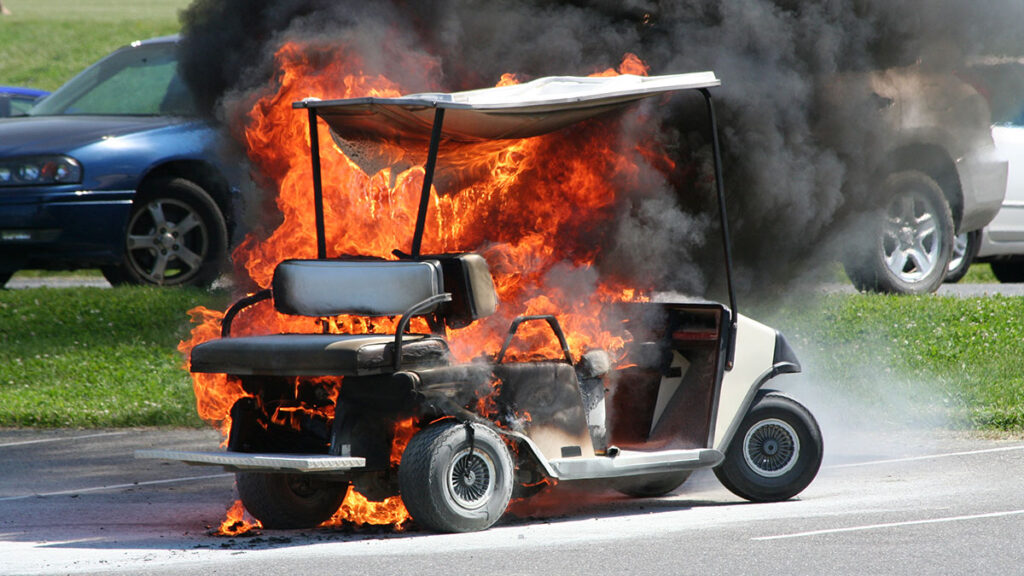-
Shopping Tools
-
Care & Maintenance
-
About
-
Dealer Login

Battery explosions in golf carts are rare but preventable. This guide explains causes, warning signs, and prevention so your cart stays safe and dependable on every charge.
The most common trigger is the ignition of hydrogen gas—a flammable byproduct released during the charging of lead-acid batteries. When gas accumulates and meets a spark, an explosion can occur. Sparks may come from loose or corroded terminals, faulty chargers, static discharge, or switching a charger on and off while the leads are attached. Overcharging, heat, and poor ventilation all increase the amount of hydrogen produced and the chance it will ignite.
Charging generates hydrogen and oxygen near the battery vents. If the area around the battery is enclosed or stagnant, gas can collect instead of dispersing. A single spark in this rich atmosphere can ignite the mixture.
Excessive charging current accelerates gassing and raises internal temperatures. Boiling electrolyte, rapid bubbling, and a strong sulfuric odor are red flags. Prolonged overcharge can deform the case, dry out cells, and push gas out of the vents faster than it can dissipate.
Charging in closets, tight sheds, or garages with windows closed concentrates gas. Without airflow, even normal charging can create an unsafe environment. Ventilation is essential—aim for cross-breeze or active extraction whenever you charge.
Using a charger not matched to your battery chemistry or voltage can overdrive the pack. Defective chargers may fail to taper current or shut off, cooking the battery and multiplying gas output. Always verify that charger settings match your battery type and pack configuration.
Loose, dirty, or corroded lugs increase resistance and heat. Arcing at the terminal is enough to ignite gas at the vent caps. Terminals should be clean, snug to spec, and protected from vibration that can work them loose.
Cracked cases, leaking electrolyte, dented lids, or melted posts signal structural compromise. Damaged batteries can vent unpredictably, short internally, and become unsafe to charge. Retire any unit with visible damage.
If any of these appear, stop charging immediately, ventilate the area, disconnect AC power to the charger first, then remove DC leads only after gas has dispersed. Avoid creating sparks and keep flames and switches away until the area is clear.
Label your charging area with a simple checklist: ventilation on, charger matched, terminals tight, tools insulated. Train anyone who uses the charger to disconnect AC first, then DC. If you upgrade to sealed lithium packs, follow the battery management system (BMS) guidelines and use the charger supplied or approved for that pack.
| Symptom | Likely Cause | Immediate Action |
|---|---|---|
| Strong sulfur odor | Overcharge / excess gassing | Shut off charger, ventilate, inspect charger settings |
| Hot battery case | High resistance or charger fault | Stop charging, cool down, check terminals and charger |
| Hissing or popping | Gas venting / boiling electrolyte | Power down, ventilate, reassess charging current |
| Terminal sparks | Loose/corroded connections | Disconnect AC, tighten/clean, recheck under load |
Set up a dedicated, ventilated charging corner with a fan and a non-sparking light switch located away from the batteries. Keep a baking-soda spill kit and eye protection nearby. Schedule monthly terminal inspections and quarterly load tests. Replace any charger that fails to taper or reaches abnormal voltages. Document settings and label cables to avoid mix-ups.
Explosions are the result of hydrogen gas meeting a spark—conditions most likely during poor charging practices, inadequate ventilation, loose connections, faulty equipment, or physical battery damage. By charging in fresh air, using the correct charger, keeping terminals tight and clean, and retiring compromised packs promptly, you dramatically reduce risk. Combine these habits with modern, well-maintained golf carts and you’ll keep every charge cycle safe, predictable, and worry-free.
